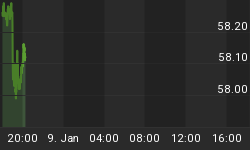I define the price cycle as the path that prices take from low to high and back again, and I use investor sentiment to help me characterize where we are in the cycle. For example, if prices are at their highs, then most likely investors are bullish; conversely, if markets are getting slammed, then investors are probably bearish. The use of investor sentiment isn't so unique that I haveany great insight, but it is how I use that data to help generate an edge.
As you know, investors were extremely bearish several weeks ago, and this is typically a bull signal. As you can see, the "dumb money" indicator, which is a weekly chart of the SP500, is shown in figure 1. This was a bull signal, and as if right on cue, the markets lifted 5%. Holy grail? No, no, no.
Figure 1. SP500/ weekly
Now look at the same figure, but this time I put a slow stochastic indicator (in black), which can be found in any normal charting package, on top of the "dumb money" indicator. (See figure 2.) I don't see much difference. Do you? Once again, there is nothing special about the sentiment indicators.
Figure 2. SP500/ weekly
However, let's get back to the price cycle. Investors are likely to get more bullish this week such that the "dumb money" indicator is going to cross above the bottom blue line (in figure 1). So let's set up the question to ask this way: 1) investor sentiment turns bearish and the "dumb money" indicator is below the blue line; 2) prices rise and the indicator crosses the blue line; 3) at this point, how often does the indicator go on to become extremely bullish and how often does the indicator rollover crossing back below the bottom blue line?
This is important because if the indicator always go onto become extremely bullish (i.e., crosses above the upper blue line) then we would know that extremes in investor sentiment always lead to higher prices. But this isn't always the case. Referring back to figure 1, since 1990, there have been 46 times the indicator went from below the bottom blue line (i.e. sentiment is bearish, bull signal) and crossed above it. In 24 of those instances the indicator ended up crossing the upper blue line (i.e., sentiment is bullish, bear signal in theory). As expected, 23 out of 24 trades were winners.
There are 22 times the indicator just rollsover without extremes in bullish ever taking place. Or to put it another way, extremes in bearish sentiment don't always lead to extremes in bullish sentiment, and in fact, it only happens about 50% of the time. So what happens when the "dumb money" indicator rolls over? 15 out of the 22 trades turn out to be losers.
So what's next for the markets? We have a 50% chance of going on to new highs, which in all likelihood would be expressed by extremes in bullish sentiment. That leaves a 50% chance of the market rolling over, and about a 33% chance of seeing prices trade below the lows of a couple of weeks ago.
What is my opinion? It doesn't really matter what I think, but I will to venture to take an educated guess. Despite the extremes seen in the "dumb money" indicator there was a lack of consensus amongst all of the sentiment indicators (i.e., dumb money and smart money) at the recent lows; since 2004, the best, sustainable price moves occur when the sentiment indicators are in alignment. In addition, my research shows and the most I can go out on a limb is this: that the lows from a couple of weeks ago should provide support for prices. If they don't, then it is look out below.















